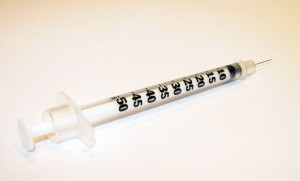In an earlier blog, I discussed DNA mapping. DNA mapping involves the analysis of an individual’s genome. This can be used to identify genetic  mutations. While ‘mutation’ sounds ominous, just like in the X-Men comics, it is not always a bad thing.
mutations. While ‘mutation’ sounds ominous, just like in the X-Men comics, it is not always a bad thing.
No Type 2 Diabetes For Me
A new study, which analyzed the genomes of 150,000 people, found that a rare mutation protects some people from getting Type 2 diabetes. This mutation even protects people who are statistically more prone to acquiring Type 2, such as individuals who are overweight.
The mutation destroys a gene used by the pancreas cells. People with this mutation produce more insulin than those who do not, and have lower blood glucose levels throughout their lives. The mutation reduces the risk of acquiring Type 2 Diabetes by two-thirds.
The Study
Four years ago, Pfizer and a group of geneticists from academia began to search for a genetic mutation that protected against diabetes. They started with populations in Finland and Sweden where 28,000 people had already been part of a study. They focused on individuals who were statistical anomalies.
The most interesting findings from this study focused on the relationship (or lack thereof) between risk factors and actually having diabetes. They found that a group of 352 people had Type 2 diabetes even though they were technically at low risk for the disease. These individuals’ average age was 50, they were physically fit, and they did not smoke. The study also identified a group of 406 people whose average age was above 80 and had high risk indicators; including smoking, obesity, and drinking. Despite their high statistical risk, this group did not have the disease. Out of these 406 people, 2 of them had a mutation that destroyed a copy of the ZnT8 gene. In mice destroying the ZnT8 gene causes Type 2 Diabetes; however, it seems in humans that the opposite happens. Since 2 people out of 406 is not statistically significant, they decided to expand their study.
The group expanded their study to include 18,000 people in Sweden of varying characteristics (age, body weight, and whether they had diabetes or not). Out of these 18,000 people they found 31 people who seemed to be protected from Type 2 Diabetes and that also had a genetic mutation which destroyed the ZnT8 gene.
To get a larger data set, the group contacted deCODE Genetics, a company with access to the genetic and medical history of the population of Iceland. They found that 39 people out of 5,440 had the mutation and did not have diabetes, while 9 out of 3,727 diabetes patients had the mutation.
Finally, they mapped 13,000 additional people and again found a correlation between the mutation and a lower risk of Type 2 Diabetes.
What Does This Mean for Diabetes?
 The hope is that this research will allow drug companies to make a drug that mimics the mutation’s effect. However, according to Timothy Rolph, a Pfizer vice president, it could be 10 to 20 years before a drug is ready to enter the market. Luckily, no bad side effects of the mutation have been found so far. If a drug can be made that replicates or uses this mutation, this could be a major breakthrough in fighting Type 2 Diabetes.
The hope is that this research will allow drug companies to make a drug that mimics the mutation’s effect. However, according to Timothy Rolph, a Pfizer vice president, it could be 10 to 20 years before a drug is ready to enter the market. Luckily, no bad side effects of the mutation have been found so far. If a drug can be made that replicates or uses this mutation, this could be a major breakthrough in fighting Type 2 Diabetes.
Written by Lauren Jensen
Leave a comment